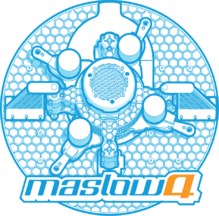
Maslow4 is a compact large format CNC router. It is the latest design in Maslow CNC family (as of 2023). It’s the next generation and complete redesign of the original Maslow.
It’s a fully open source and low cost alternative to large format CNC routers that is accessible to individuals. It’s mainly envisioned as a tool that will allow individual makers to cut designs like OpenDesk at their home or garage. It doesn’t require excessive space, can be set up in minutes and can work over large formats up to 8’ x 4’ with millimeter precision.
The main features of this design are that it is compact, and even portable (depending on the definition of the word). And it can also work at a variety of angles - from fully horizontal, to almost vertical (up to 75 degrees), drastically reducing the space requirements for a large format CNC router.
All the Maslow4 design files, firmware and software are distributed under GNU(?) license.
Maslow4 is supported by the Tolocar project.
General Information[edit | edit source]

Maslow 4 is part of a family of robots known as tensegrity robots which means it uses members under tension to move. This allows Maslow 4 to make precise movements without expensive or precision rigid components. Maslow 4 uses four steel reinforced belts to fully constrain its position on the cutting surface.
The custom five axis control board drives four high power DC servo motors (planetary gear boxes with magnetic encoders) and two stepper motors (for the z-axis). Each servo axis is independently controlled and has real time current feedback to let Maslow “feel” the tension in each belt. The controller has Wi-Fi, Bluetooth, and USB C connections.
Maslow4 can be controlled from any Windows, Linux, Mac, i-OS, or Android (no app or software download required) device with a Wi-Fi connection by connecting directly to the Maslow Wi-Fi network that the device creates, or by connecting Maslow to your home network if you have one. NO INTERNET CONNECTION IS REQUIRED. Bluetooth and USB C connections are also available.
Maslow 4 is fully self calibrating Maslow 4 automatically uses its servo motors to make a series of movements and measurements (by pulling in on its belts until it senses that they are taught) recording the results. It then uses a genetic algorithm to “evolve” the precise calibration.
The anchor points can be any four rigid points. They do not need to be precisely spaced or rectangular.
Background[edit | edit source]
Six years ago the Open Source CNC Router (Maslow) was introduced.
Through the realization of a campaign, a diversity of designs were built and a community of people around the world was formed. From that experience, all the lessons learned were taken into account for the construction of Maslow 4.
Maslow 4 is a complete redesing of the original machine but improved.
What are the benefits of this solution?[edit | edit source]
The benefits of Maslow 4 are:
- It can be connected over a Wi-Fi with any modem browser.
- It's easy to assemble, no special tools are required.
- The Wi-Fi controller is much faster and self-calibrating.
Mechanical Design[edit | edit source]
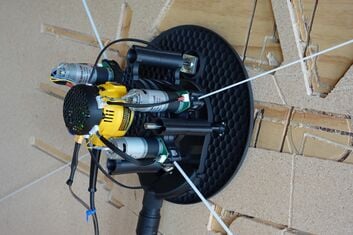
Maslow4 consists of 4 “arms” rotating around the router body, fixed between two “clamps” fixed around the router body. The router is then mounted on the “sled”, at four points, two of them are Z axis stepper motor shafts, and two - sliding on the poles attached to the sled with the help of 4 linear ball bearings.
The router body can move up and down with two Z axis stepper motors. The whole machine is moved by a motor in each of the Arms, that is pulling on or releasing the belts, changing the router position on the cutting surface.
The arms can freely rotate around the body, so that the tension in the belts always aligns them in a way, so that extensions of the belts always coincide in the center of the router. This greatly simplifies the inner math of the program and reduces error.
Unlike the original Maslow, in Maslow4 all of the electronics and components are mounted on the sled. This gives users a total freedom of mounting options. The frame for Maslow4 could be any 4 rigid anchor points. For example, this could be a frame made out of wood or aluminum, or just for anchors drilled into the floor, or a concrete driveway.
Maslow4 keeps track of its position solely by measuring its belt lengths. Each arm is fitted with an encoder board, that measures an absolute position of the roller, through which the belt is passed, using a magnet fitted inside the roller.
Algorithm[edit | edit source]
General math of positioning[edit | edit source]
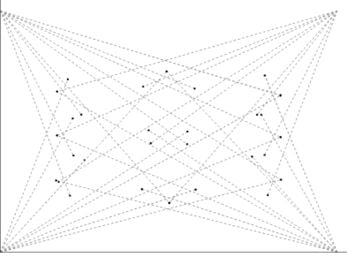
Maslow4 uses no other inputs but belt lengths to determine its position on the working area.
Theoretically, knowing the position of the anchor points, you would only need to know lengths of two belts to determine the position. The position is at a point of intersection of two circles with the radiuses of belt lengths centered at the anchor points. There are usually two points that fit this equation, however one of those always lies outside of the working area and can be disregarded.
Maslow4 uses 4 belts to determine it's position.
Calibration process[edit | edit source]
To determine it's position on XY plane, the machine needs to know the distances towards the anchor points, but this requires a very precise knowledge of the anchor positions. This is one of the challenges of machines of this kind. Determining of the actual coordinates of the anchor points proved to be a big challenge for most setups and individuals.
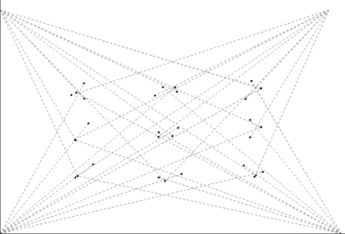
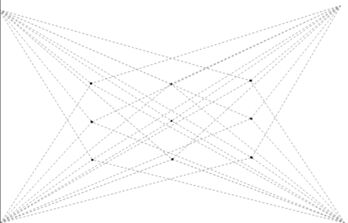
For these reasons, Maslow4 utilizes a new calibration process, that determines the coordinates of anchor points.
Maslow4 starts with the approximate values for the XY coordinates of the anchor points. First we retract all 4 belts to the zero position, to calibrate the zero length position for the belts. The belts are then extended and fixed to the points, and Maslow begins to mover through a 10x10 grid of points scattered over the center of the working area. At each of the points, machine retracts two of the bottom belts till they are under tension, detecting tension using the current feedback from the motors. It then takes measurements for the lengths of tensioned belts at each of the points. We get a 100 sets of belt lengths this way.
These measurements, if the anchor point coordinates are right, should all be able to coincide at the same points. Since we start with the approximation of the coordinates, we use the following "evolutional" algorithm to find the real solution.
- First, by moving each set of measurements along the angle of the belt against the coordinate plane, we determine the set of angles, where the belt ends of the each respective set are the closest to each other.
- Then we determine the anchor point, which belt ends would be the most removed from the other belt ends.
- We determine the direction into which we need to nudge the anchor point position in order to decrease this difference.
- We nudge the point into said direction.
- Go back to 1.
We continue running this cycle until we get to the global minimum of the solution - a solution, where average distances between belt ends are minimal and can no longer be improved by nudging of any of the anchor points in any direction. This gives us the solution closest to the real one.
Hardware[edit | edit source]
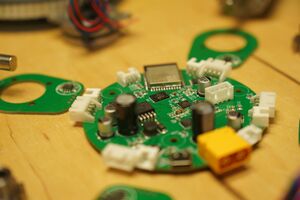
Maslow4 control board is a custom designed open source PCB. The main controller is ESP32-S3 chip. It controls 4 DC motors, through motor driver boards, 4 magnetic encoders, two Z-axis stepper motors, built-in SD memory, and a cooling fan.
Firmware[edit | edit source]
Maslow4 is a branch of an open source CNC firmware FluidNC (previously Grbl_Esp32). It utilizes it's own specific maslow config file, and uses the same Web Interface, based on another open source ESP3D-UI project, with some minor changes. The Web Interface allows full control of the machine. From calibration, reporting the status, to watching the file that is being cut in real time. It supports standard g-code files, that could be loaded through the web interface.
The Web interface allows Maslow4 to be controlled from any platform and browser, on the low-end and older machines.
Parts and Assembly[edit | edit source]
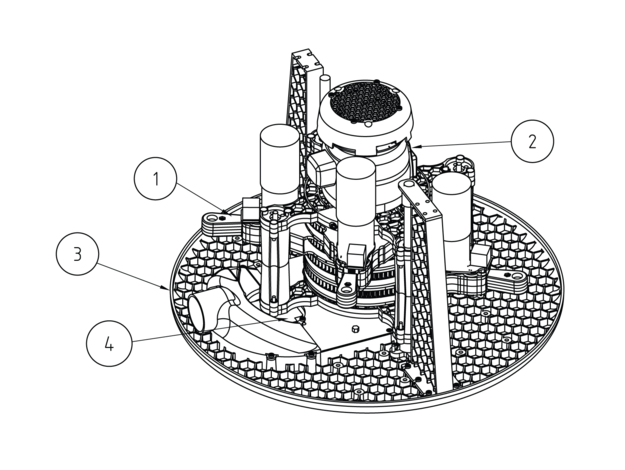
Maslow4 is built around the DeWalt DWP611 router (DeWalt 26200 for Europeans) hand held CNC router. It consists of 4 "Arms", that rotate around the router body, sandwiched between two "Clamps", that hold the Arms together. They are then attached to the "Sled", with two stepper motors, and 2 supporting poles.
The router with Arms can then slide up and down, relative to the sled, driven by two Z-axis stepper motors.
The controlling board is fixed to a plastic base, that clamps to the DeWalt router. It has a cover with a built-in cooling fan. The routers air cooling is also used for better cooling of the board.
The Sled has a dust collection system with a dust hose port, where any vacuum can be connected for dust collecting.
Each of the Arms consists of a plastic base, with DC motor and an encoder board attached to it. the DC motor with a gearbox, is connected through the gears to the main spool gear, around which the belt is coiled. The belt comes out of the arm between two rollers, one of which has a built-in magnet, that is used for measuring the extension of the belt.
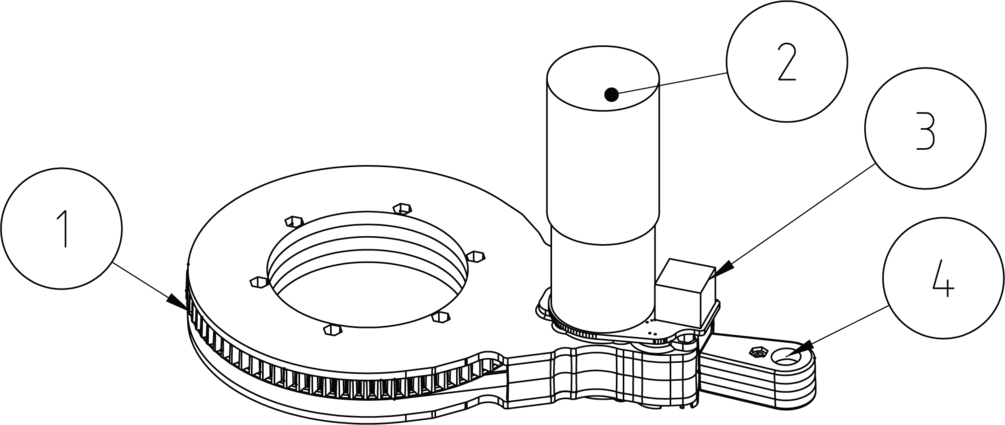
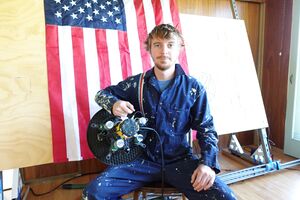
Impact[edit | edit source]
Maslow4 is designed to be an affordable large-format CNC router, that is cheap enough for most of people. It's specs are more then enough for most projects like making custom furniture and fixtures for home from open designs. This will allow for a more decentralized and democratic manufacturing of things like furniture. A larger goal is making housing more affordable, by boosting the ecosystem of open-source CNC, and incentivizing the creation of more open designs that individuals can use. Houses and housing structures are among those designs, and could potentially make building houses at a way cheaper price than the market.
Gallery[edit | edit source]
References[edit | edit source]
- https://www.maslowcnc.com/ - the official Maslow project website.
- https://forums.maslowcnc.com/ - official Maslow CNC forums
